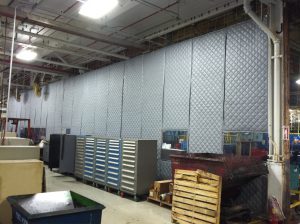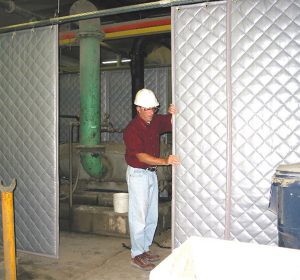How Do Soundproof Curtains Work
Soundproofing Curtains
High noise levels can cause many problems such as poor communication, unhealthy work environment, hearing loss, unhappy employees, OSHA violations. Whether you work in an office or the shop floor, there are always some type of unwanted noise that disrupts the workplace. That’s where soundproof curtains can help.
Using soundproof curtains can reduce the noise from noisy equipment and processes. The term “soundproof curtains” is a laymen’s term for the product. The technical name is “sound curtains” or “sound blankets.” HVAC equipment, air compressors, vacuum pumps and process noise can be improved by using these curtains.
“Soundproof” Curtains – Do They Actually Work?
Many types of equipment or processes make extremely loud noise like plastic grinders, Positive displacement blowers, stamping presses. Because of the sound frequency on high sound levels this equipment emits, sound curtains will not completely eliminate all the noise being generated, but they can certainly make the environment better with the installation.
How Noise Reducing Curtains Work
Soundproofing curtains are also called Acoustic Drapes, Acoustic Curtains, Soundproof Blankets, Sound Blankets, Sound Screens, Acoustic Barriers, Acoustic Drapes, Acoustic Screens.
The curtains are designed and made with materials specifically used for sound control. The curtains are sound absorbers that reduce the reflected sound bouncing around a room. Also, the Soundproofing curtains are sound barrier s cutting down the noise from entering a space.
Acoustic curtains have shown to reduce the transmission of sound by up to 29db. The performance may vary based on the quality of materials used and your specific application. The reduction in noise is useful in many locations, like theaters, churches, offices, and even as an enclosure for loud industrial machinery. Acoustical curtains are made with difference facings and internal components depending on what environment they will be used in.
Typically 1 to 4 inches thick, the Soundproofing blankets are manufactured of acoustical grade quilted fiberglass absorber in one or multiple layers with a sewn facing diamond stitched. The curtains may included a ½ to 2 pound sound barrier that is reinforced or non-reinforced. The blankets have all edges bound with industrial grade Velcro on the vertical edges and grommets across the top for suspension.
Mass or weight blocks noise, so thick and heavy materials are used to enhance the performance of the blankets.
Industrial Soundproofing Curtains
This type of soundproofing curtains are made from very rugged materials to stand up to heavy abuse of the industrial or construction environments. A heavy vinyl or VCP are used for the blanket facings and loaded vinyl sound barriers that replaced lead sheets add superior sound blocking to the blankets. The acoustic soundproof curtains can be made into enclosures around noisy equipment or separate an entire noisy area of the industrial plant.
Installing a soundproof curtain enclosures around loud equipment like pumps, generators, compressors vacuum pumps, and dust collectors will make the workplace more tolerable for employees.
Also, where heavy commercial construction site is located near residential neighborhoods or in a densely populated city, noise of earth-moving equipment, jackhammers, and heavy trucks. The construction site is will be surrounded by soundproof curtain fence. This will greatly reduce the noise reaching the nearby homes.
How to Use Soundproofing Curtains to Quiet Noisy Industrial Equipment
Treat the Room with Sound Proofing Curtains
This is done by hanging a specific amount of soundproof curtains around the room to reduce reflected noise. The maximum noise reduction is 6-9 decibels (30-40% decrease in loudness). The advantages are no inconvenience to workers. The disadvantages is that almost all of the room must be treated regardless of the size of the noise source.
Treat the Wall Behind the Noisy Industrial Equipment with Sound Proofing Curtains
This is down by hanging sound proofing curtains on the wall behind the equipment The maximum noise reduction is 1-2 decibels if noise source sprays noise out into room, 4-6 decibels if noise is sprayed directly onto wall (such as noisy vent on the back of a machine). The advantages are no inconvenience to workers. The recommended amount of Sound proofing curtain to add to the wall behind the machine is approximately twice the square footage of the “noise shadow” of the machine on the wall.
Build a Barrier Wall or Partial Enclosure with Sound Proofing Curtains
This is done by installing a ceiling hung or floor mounted frame with sound proofing curtains. The maximum noise reduction is 6-15 decibels. Advantages are a very good reduction of noise. You may need to incorporate view windows for visibility and/or sliding panels for access. What Size do I make the soundproof curtain wall? At a minimum, 8′ high. Typically, the barrier should be double the height of the noise source.
Build a Complete Noise Enclosure with Sound Proofing Curtains.
This is done by erecting a ceiling suspended or floor mounted frame with four walls and a roof constructed of sound curtains. Typical noise reduction of up to 15- 20 decibels. The advantages are to achieve the maximum noise reduction possible. You may be required to incorporate view windows for visibility and/or sliding panels for access as well as ventilation baffle(s) for air flow for cooling the motor.
The Pros and Cons of Soundproof Curtains
Soundproof curtains offer several benefits to industrial and construction sites that can help control the noise, however, there are a few things to consider before you make a purchase. If you are unsure if they can help you, then let’s look at both the pros and cons.
Pros
-
They reduce exterior and interior sound transmission and reverberation.
-
They provide a thermal barrier keeping heat or air conditioning inside.
-
They provide a light barrier
- Soundproof curtains are durable
Cons
-
The sound proof curtains are heavy and will require adequate structure for support.
- They are industrial looking with the quilted facings and though they are functional, are not pleasing to the eye.













